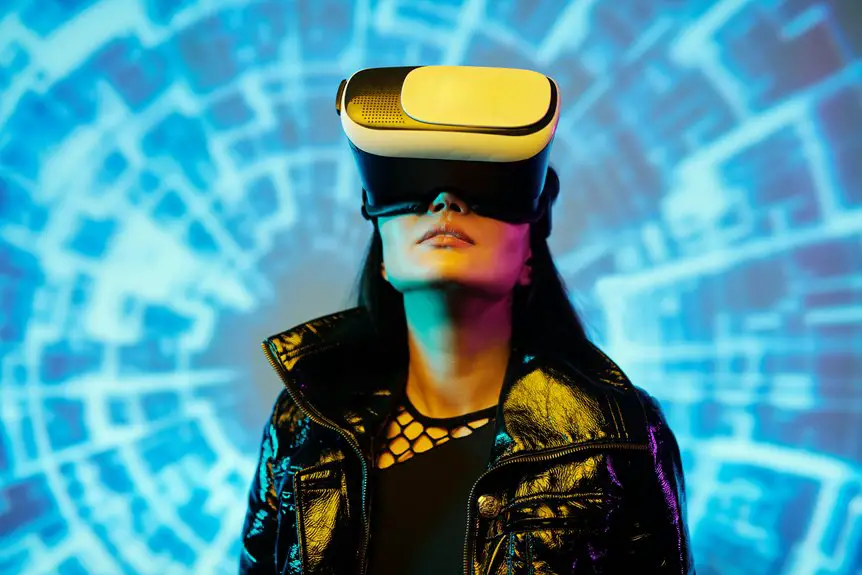As a field service technician, you know the challenges of keeping operations running smoothly. Augmented Reality (AR) is changing the game, offering innovative solutions that enhance your efficiency and improve customer interactions. From real-time troubleshooting to interactive training manuals, AR tools are making a significant impact. But what does this mean for your daily tasks and the future of your role? Let’s explore some compelling real-world examples that illustrate AR’s potential in your field.
Table of Contents
Key Takeaways
- AR tools enable technicians to visualize equipment issues in real-time, enhancing problem resolution efficiency and reducing downtime significantly.
- Interactive manuals with AR features provide immersive training experiences, allowing technicians to practice in a safe environment and improve their skills.
- Real-time AR overlays guide technicians with visual instructions, streamlining workflows and minimizing errors during repairs.
- AR technology enhances customer engagement by providing clear, interactive visual aids that foster a collaborative atmosphere during service interactions.
- Predictive maintenance capabilities using AR can proactively identify potential issues, leading to improved service delivery and customer satisfaction.
Enhancing Remote Assistance With AR
As you navigate complex field service tasks, enhancing remote assistance with augmented reality (AR) can be a game changer. AR tools allow you to visualize equipment issues in real-time, overlaying digital information directly onto your field of view.
Imagine getting step-by-step guidance from a remote expert while you work, considerably reducing downtime. With AR, you can access schematics, maintenance logs, and troubleshooting tips without flipping through manuals or fumbling with devices.
You’ll find that this technology not only boosts your confidence but also improves accuracy in repairs. Plus, it fosters collaboration, allowing you to troubleshoot alongside colleagues or specialists, no matter where they are.
Embracing AR empowers you to tackle challenges more efficiently and effectively.
Interactive Manuals: A New Way to Train Technicians
Interactive manuals are transforming the way you learn and train as a technician.
With enhanced learning experiences and real-time guidance features, you can tackle complex tasks more effectively.
This innovative approach not only boosts your skills but also increases your confidence on the job.
Enhanced Learning Experience
While traditional training methods often rely on static manuals and lengthy lectures, augmented reality (AR) is revolutionizing how technicians learn.
With interactive manuals, you can engage with 3D models and simulations that provide a hands-on experience. Instead of just reading about complex machinery, you can visualize components in real time, making it easier to understand their functions.
This immersive learning approach allows you to practice tasks in a safe environment, building your confidence before you tackle real-world challenges. Plus, AR can adapt to your learning pace, ensuring you grasp concepts thoroughly.
Real-Time Guidance Features
When tackling complex repairs, having real-time guidance can make all the difference in a technician’s efficiency and confidence.
With interactive manuals powered by AR technology, you can access step-by-step instructions right in your field of vision. These manuals overlay visual cues on the equipment, helping you identify parts and procedures instantly. You won’t have to flip through pages or search online; everything you need is at your fingertips.
Additionally, real-time troubleshooting features can alert you to potential issues before they escalate, ensuring a smoother repair process. By utilizing these tools, you not only enhance your skills but also streamline your work, leading to quicker resolutions and happier customers.
Embrace this innovative training approach to elevate your service capabilities.
Real-Time Troubleshooting Using AR Solutions
When you’re faced with a technical issue, AR solutions can provide enhanced visual guidance to help you troubleshoot effectively.
You can also collaborate with remote experts in real-time, allowing for quicker resolutions.
With interactive troubleshooting tools at your fingertips, you’ll tackle problems more efficiently than ever.
Enhanced Visual Guidance
As you navigate complex repairs in the field, augmented reality (AR) solutions provide enhanced visual guidance that can transform your troubleshooting process.
With AR, you’re able to overlay digital information directly onto the physical environment, allowing you to visualize components and procedures in real time. Imagine looking at a machine and seeing step-by-step instructions or highlighted areas that need your attention.
This visual context helps you identify problems faster and reduces the chance of errors. You can also view 3D models of parts, making it easier to understand their placement and function.
Remote Expert Collaboration
Building on the enhanced visual guidance offered by AR, remote expert collaboration takes troubleshooting to the next level. You can connect with specialists in real-time, sharing what you see through your AR device. This instant communication allows you to receive immediate feedback and guidance, reducing downtime and boosting efficiency.
Here’s how remote expert collaboration can enhance your troubleshooting experience:
| Feature | Benefit |
|---|---|
| Live Video Feed | Expert guidance in real-time |
| AR Annotations | Clear instructions on-screen |
| Instant Messaging | Quick Q&A for clarification |
| Data Sharing | Access to manuals and diagrams |
With these tools, you’ll feel more empowered to tackle complex issues efficiently.
Interactive Troubleshooting Tools
Interactive troubleshooting tools powered by AR enable you to diagnose and resolve issues in real-time, enhancing your efficiency on the job.
With these tools, you can overlay digital information onto physical equipment, guiding you through complex repairs step-by-step. Imagine pointing your device at a malfunctioning machine and instantly receiving visual instructions, troubleshooting tips, or even schematic diagrams.
This immediate access to critical information reduces downtime and minimizes errors. You can also capture and share your findings with colleagues or experts, ensuring collaborative problem-solving.
By leveraging AR technology, you’ll navigate repairs more confidently and effectively, ultimately boosting your productivity and customer satisfaction.
Embrace these interactive tools to transform your field service experience.
Streamlining Repairs With AR Overlays
When tackling complex repairs, AR overlays can greatly enhance your efficiency and accuracy. They provide real-time, visual instructions directly on the equipment, allowing you to see precisely where to focus your efforts. Instead of flipping through manuals or searching online, you’ll have step-by-step guidance right in your line of sight.
These overlays can also highlight critical components, making it easier to identify issues and avoid common mistakes. You’ll streamline your workflow as AR tools help you visualize the repair process, reducing the time spent troubleshooting.
Additionally, with AR’s interactive features, you can quickly access parts lists and service history, ensuring you’re fully prepared. Embracing AR overlays can transform your repair approach, leading to faster and more accurate service.
Improving Customer Engagement Through AR Experiences
AR technology doesn’t just streamline repairs; it also enhances your interactions with customers. By using AR experiences, you can provide real-time visual aids that help customers understand the issues at hand.
Imagine showing them exactly what you’re fixing through an interactive overlay, making complex problems clearer and more relatable. This transparency can build trust and foster a collaborative atmosphere.
Customers appreciate being involved, and with AR, you can guide them through the repair process step-by-step. Furthermore, you can offer personalized recommendations for future maintenance, making your service feel more tailored and attentive.
Ultimately, AR not only improves the efficiency of your work but also transforms customer engagement, turning routine visits into meaningful interactions.
Case Studies: Successful AR Implementations in Field Service
Though many companies are still exploring the potential of augmented reality, several have already successfully integrated AR into their field service operations.
For instance, a leading HVAC provider utilized AR glasses to enable technicians to access real-time data and receive step-by-step guidance during installations. This not only reduced errors but also sped up job completion.
Another example is a telecommunications company that implemented AR to assist technicians in diagnosing network issues. By overlaying critical information on their field of view, technicians resolved problems faster, enhancing customer satisfaction.
These case studies highlight how adopting AR can streamline processes, boost efficiency, and improve service quality, demonstrating AR’s transformative potential in field service environments.
You can see the clear benefits of such implementations firsthand.
The Future of AR in Field Service Operations
As technology continues to evolve, the future of AR in field service operations promises to be both exciting and transformative.
Imagine stepping into a world where complex repairs become straightforward with AR guidance overlaying real-time data. You’ll have access to remote experts, visual aids, and step-by-step instructions directly in your field of view, reducing errors and downtime.
Predictive maintenance will become a reality, allowing you to anticipate issues before they arise.
Training new technicians will also accelerate, as immersive AR experiences simulate real-world scenarios without the risks.
Overall, AR will enhance your efficiency, boost customer satisfaction, and redefine how you approach field service work, making it more intuitive and effective than ever before.
The future’s looking bright!
Frequently Asked Questions
What Industries Benefit Most From AR in Field Service?
You’ll find industries like manufacturing, healthcare, and telecommunications benefiting most from AR in field service. These sectors enhance efficiency, reduce errors, and improve training, allowing technicians to solve problems faster and deliver better customer experiences.
How Much Does AR Technology Typically Cost for Implementation?
AR technology implementation costs vary widely, typically ranging from a few thousand to several hundred thousand dollars, depending on the project’s scope, software, hardware, and ongoing maintenance. You should carefully assess your specific needs before diving in.
What ARe the Hardware Requirements for AR Applications?
For AR applications, you’ll need compatible hardware like smartphones, tablets, or smart glasses. Make certain you have a strong processor, adequate RAM, and a high-quality camera to support immersive experiences and smooth functionality.
Can AR Be Integrated With Existing Field Service Management Software?
Yes, you can integrate AR with existing field service management software. This integration enhances efficiency, allowing you to access real-time data and improve communication, ultimately optimizing your workflow and boosting customer satisfaction.
What Skills ARe Needed for Technicians to Use AR Effectively?
To use AR effectively, you’ll need strong technical skills, adaptability, problem-solving abilities, and a good understanding of the equipment. Communication skills also help when collaborating with team members and customers during AR-enhanced tasks.




